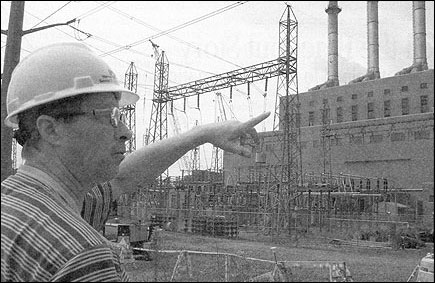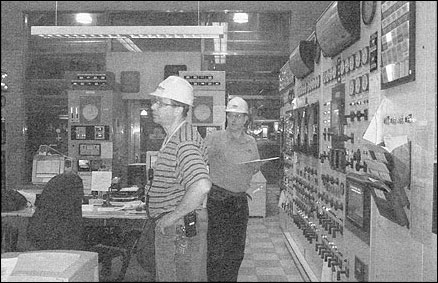High on a catwalk, I paused to look down into the dim void between two 90-foot-high boilers, steel-riveted dinosaurs of another era guzzling hundreds of gallons of heavy #6 fuel oil each minute. It was late on a hot Saturday afternoon in August 2003, and I was deep inside the Albany Steam Station, a 1950’s power plant owned by PSEG Power, a New York utility. An enormous monolithic brick building hard by the Hudson River, it housed four giant-but-elderly boilers—two of them growling beneath my feet—straining to generate the super-heated steam and megawatts desperately needed to re-energize the Northeast power grid, darkened by the largest blackout in U.S. history.
Power was slowly being restored by the time I found myself there—two days after the lights went out. Sweat poured off me in the 120-degree heat of the tight, dimly lit passage between the giant boilers. A few steps away, station manager Wayne Bolton-Engelhardt, who had brought me to the highest and hottest level of the boiler building, spoke with a bemused smile, his brow barely damp. Amid the din, I strained to hear Bolton-Engelhardt speak, as waste heat pulsed from the steel walls into this hot spot where a human could linger only a few minutes. Notepad out, I scribbled as he explained how he and his men had brought the old plant—which like so many others had been knocked into darkness by the blackout—back to life and how the crew, with a synchronization NASA might envy, ever-so-gingerly snapped it back into the grid the day before. As he spoke, four 100-mega-watt turbines far below were greedily receiving the 1,000-degree steam each boiler shot into them. They were all spinning flat out.
Despite the Dante-esque quality of the moment, there was joy and excitement, too. I had finally arrived where I had been struggling to get to—inside the belly of a generating behemoth, the bowels of an Eisenhower-era power station straining desperately against its own age to pour its pitifully small, yet still critical 400 megawatts of electricity, into the vast emptiness of the Northeast grid.
Wayne Bolton-Engelhardt, an operations adviser at Albany Steam Station in New York, recounts the blackout. It was the second time the plant had ever gone dark. Photo by © 2003 Mark Clayton/The Christian Science Monitor.
How to Report the Blackout
Like so many calamities, the great blackout of 2003—that knocked out power for millions from New York to Michigan—was both a great news story to tell and a mystery. Early reports rumored a lightning strike at a power yard in Canada near Niagara Falls had knocked the system down. Some speculated terrorism might be responsible. It would be weeks and months, and an investigation by an official commission, before the pieces of truth began to fit into a coherent picture of human and technical error involving computer software, lax standards, and poor communication.
In Boston, where I work at The Christian Science Monitor, the lights had not gone out in the newsroom, and television and wire service reports in the first hours were, naturally enough, bare bones. Someone, I thought, should get into a generating plant to tell the story of just one power plant’s role in the huge network that had gone suddenly dark. Downsizing this massive outage to one plant might yield insights into what went wrong and capture the human dimension, too.
I began my quest with only faint hope of actually wangling my way inside any power plant. Because of terrorism rumors, security was extra tight, and the big energy companies and their public relations armies were on full alert. Phone lines were jammed, too. I immediately decided not to bother calling any company headquarters. The only way into one of those plants was to be invited inside by one of its senior employees. Yet those people would be under intense pressure to solve a mountain of technical problems that “civilians” like myself could barely imagine in order to get the lights back on, making it quite unlikely that any would welcome a reporter at this time.
But this was the only way I could think of getting in, so I began my search with Google, looking for Web sites and phone numbers of those connected to the power industry, the power stations, industry associations, and regional power authorities. I was looking now for anyone who might pick up a phone and talk to me—who might in turn know someone inside one of those big power plants. By day’s end, I’d had no success.
This was not too surprising. Back then, I was not an energy writer with a long list of great sources. I was an education reporter with no energy sources. (When the blackout occurred, I was working on a college tuition increase story. Today I write full-time about both environment and energy issues.) At other major newspapers with much larger staffs it might seem odd for an education writer to jump onto a story like this. Yet the Monitor has a long tradition of successfully drawing on all corners of the newsroom when major events break. And the blackout had more than a little of that 9/11 feeling, thanks to the first day’s terrorism rumors. So I dropped the tuition story and began pondering power plants.
By the next morning, power still wasn’t back on in New York. This encouraged me to continue pursuing my idea. Also, most TV and newspaper accounts seemed to be relying on engineering professors and power company representatives to give them a clue about what might be going on. I’d seen no reports of what had happened coming from anyone inside those power plants. Finally lightning struck as I recalled a casual conversation with the boiler maintenance chief in the basement of the Monitor building who had told me he once had worked in a power plant. I called him. Where had he worked? When? (Twenty-six years ago.) Did he still know anyone at the plant? It was the Albany plant—and he knew a guy who he thought still worked there.
I spent the rest of the day trying to reach the contact he’d suggested— Bolton-Engelhardt. To find his home number and leave messages, I used switchboard.com. His wife called me back. Her husband was at the plant, working to get it back on the grid. I told her it was urgent. She took a message, but also reluctantly gave me her husband’s work number in the control room at the Albany Steam Station. I reached him in the middle of multiple crises at the station that Friday afternoon. I told him who I was—and he told me tersely that he could not talk. I pleaded for him to call me when he could and gave him my number. It was the next day before he called me back at my home. We talked for more than an hour—and, finally, he told me I could come take a look if I wanted. The plant had been back on line only a few hours. I was out the door.
After touring the boilers, I went with Bolton-Engelhardt to the control room. There I interviewed a half dozen men, most of them industry veterans who had seen the computer printout spit out warning of a troubling frequency fluctuation on the grid. I learned how the lights went out, the ensuing confusion punctuated by battery-backup warning sirens and banks of flashing control-panel warning lights. It was almost like the movies.
I learned, too, how the emergency power had come on for the Albany Steam Station for only the second time in its history. But I also found out that the power wasn’t nearly enough to avoid rapidly escalating danger to its four big turbines. And there was the threat that the entire plant might not be able to come back online if those turbines failed. I was told about how multiple crisis conditions had rapidly developed—among them the threat of a dangerous hydrogen leak—and also how the sheer weight of the one huge turbine, spinning at thousands of RPM’s when the blackout struck, would warp its thick axle and be lost if the plant remained on emergency battery power for more than a few minutes. With only minutes remaining before these escalating crises would culminate, Bolton-Engelhardt and his team talked through a situation only he and another engineer on the team had seen once before, and that was during a blackout in the 1960’s.
With the help of Bolton-Engelhardt and others in the control room, I reconstructed a narrative account of what took place during these precious minutes. I found out how the team had picked two critical relays out of a wall full of hand-thrown relays, selecting the two that connected them with a nearby hydroelectric dam that was their reserve backup. This was a system they had never really used before. They threw the switch and prayed it would connect—though it didn’t the first time. But the second time it did, and thousands of watts suddenly flowing from the small dam lit up the Albany Steam Station, as its corridor lights suddenly went from winking dim “fireflies” to fully on.
Hours later, after the boilers were brought up and the turbines were spinning, the tense and delicate process of connecting the station to a still unstable grid might have knocked the entire station back off line. But it didn’t.
Wayne Bolton-Engelhardt and a colleague in the control room at the Albany Steam Station. Photo by Mark Clayton.
What Readers Learned
Monitor readers were among the first in the nation to find out what had happened minute-by-minute inside a small and old, yet critical plant on a key power pathway in the wake of this enormous blackout. They were among the first to learn, too, one of the clues to the system’s failure: A strange variety of electricity measured in “megavars”—not megawatts—that was vital to maintaining the stability of the grid was, for some reason, in short supply. This odd duck of the power-generating world called “push-back power” and “reactive power” turns out to be a kind of electricity the Albany Steam Station specializes in supplying. It provides stability and back-pressure to keep the megawatts of much larger power plants flowing where they needed to go—to places south like New York City.
I took pictures with my digital camera and raced for home on the Massachusetts Turnpike. By nine o’clock on Saturday night, I was ready to write, and by seven the next morning, the story and pictures were in an e-mail message to the Monitor’s assistant managing editor for features, Cheryl Sullivan. She did a quick edit, then handed it to National News Editor Scott Armstrong and, in Monday’s paper, the lead story on the blackout, written by a team of staffers, was accompanied by a tick-tock tale from “Inside the Belly of a Generating Beast.” Like Col. Kilgore in “Apocalypse Now,” I felt that something about the whole story smelled like victory. Still, that sensation might have just come from the essence of sweat and #6 fuel oil on my shirt.
Mark Clayton is a staff writer for The Christian Science Monitor. “Inside the Belly of a Generating Beast” can be found at www.csmonitor.com/2003/0818/p01s02-usec.html.



